Slynurse
On this page, you find all documents, package deals, and flashcards offered by seller Slynurse.
- 207
- 0
- 7
Community
- Followers
- Following
214 items
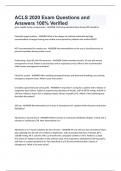
ACLS 2020 Exam Questions and Answers 100% Verified
given rapidly during compressions - ANSWER-IV/IO drug administration during CPR should be Potential oxygen toxicity - ANSWER-What is the danger of routinely administering high concentrations of oxygen during post-cardiac arrest period for patients who achieve ROSC? NOT recommended for routine use - ANSWER-Recommendation on the use of cricoid pressure to prevent aspiration during cardiac arrest Performing a head tilt chin lift maneuver - ANSWER-Family members found a 45 year old woman un...
- Exam (elaborations)
- • 5 pages •
given rapidly during compressions - ANSWER-IV/IO drug administration during CPR should be Potential oxygen toxicity - ANSWER-What is the danger of routinely administering high concentrations of oxygen during post-cardiac arrest period for patients who achieve ROSC? NOT recommended for routine use - ANSWER-Recommendation on the use of cricoid pressure to prevent aspiration during cardiac arrest Performing a head tilt chin lift maneuver - ANSWER-Family members found a 45 year old woman un...
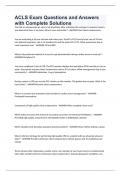
ACLS Exam Questions and Answers with Complete Solutions
You find an unresponsive pt. who is not breathing. After activating the emergency response system, you determine there is no pulse. What is your next action? - ANSWER-Start chest compressions You are evaluating a 58 year old man with chest pain. The BP is 92/50 and a heart rate of 92/min, non-labored respiratory rate is 14 breaths/min and the pulse O2 is 97%. What assessment step is most important now? - ANSWER-12 lead EKG What is the preferred method of access for epi administration durin...
- Exam (elaborations)
- • 9 pages •
You find an unresponsive pt. who is not breathing. After activating the emergency response system, you determine there is no pulse. What is your next action? - ANSWER-Start chest compressions You are evaluating a 58 year old man with chest pain. The BP is 92/50 and a heart rate of 92/min, non-labored respiratory rate is 14 breaths/min and the pulse O2 is 97%. What assessment step is most important now? - ANSWER-12 lead EKG What is the preferred method of access for epi administration durin...
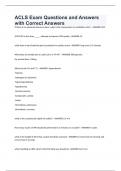
ACLS Exam Bundle Questions and Answers 100^% Accurate
ACLS Exam Bundle Questions and Answers 100^% Accurate
- Package deal
- • 54 items •
- ACLS COMPLETE 2021 Exam Questions and Solved Answers • Exam (elaborations)
- ACLS Written Exam Questions and Answers 100% Verified • Exam (elaborations)
- ACLS: FINAL TEST QUESTIONS AND ANSWERS with Complete Solutions • Exam (elaborations)
- ACLS Exam Questions and Answers 100% Accurate • Exam (elaborations)
- ACLS pretest Exam Questions and Answers with Solutions by Experts • Exam (elaborations)
- And more ….
ACLS Exam Bundle Questions and Answers 100^% Accurate

ACLS Cardiac Arrest Exam Questions and Answers 100% Verified
What are the doses for epi? vasopressin? Amiodarone? Lidacane is used if amio is not there. Dose for lida? - ANSWER-Epi = 1mg q5min, Vasopression 40U IV, amio - not sure! Lida = 100mg What are the main steps in ACLS cardiac arrest scenarios? - ANSWER-1. Call code 2. Start CPR. 3. IV/O2/monitor 3. Check rhythm. 4. If shockable rhythm, shock. Then do another cycle of CPR. Then again rhythm check & shock, then CPR...As doing cycles of CPR there are 4 things you do on each cycle. A. Get IV or IO...
- Exam (elaborations)
- • 3 pages •
What are the doses for epi? vasopressin? Amiodarone? Lidacane is used if amio is not there. Dose for lida? - ANSWER-Epi = 1mg q5min, Vasopression 40U IV, amio - not sure! Lida = 100mg What are the main steps in ACLS cardiac arrest scenarios? - ANSWER-1. Call code 2. Start CPR. 3. IV/O2/monitor 3. Check rhythm. 4. If shockable rhythm, shock. Then do another cycle of CPR. Then again rhythm check & shock, then CPR...As doing cycles of CPR there are 4 things you do on each cycle. A. Get IV or IO...

ACLS Exam Questions and Answers with Correct Answers
if there is no advanced airway in place, what is the compression to ventilation ratio? - ANSWER-30:2 if PETCO2 is less than _____, attempt to improve CPR quality - ANSWER-10 what dose of epi should be given to patients in cardiac arrest - ANSWER-1mg every 3-5 minutes What dose of amiodarone is used if pt is in VT/VF? - ANSWER-300mg bolus for second dose: 150mg What are the H's and T's? - ANSWER--hypovolemia -hypoxia -hydrogen ion (acidosis) -hypo/hyperkalemia -hypothermia -...
- Package deal
- Exam (elaborations)
- • 6 pages •
if there is no advanced airway in place, what is the compression to ventilation ratio? - ANSWER-30:2 if PETCO2 is less than _____, attempt to improve CPR quality - ANSWER-10 what dose of epi should be given to patients in cardiac arrest - ANSWER-1mg every 3-5 minutes What dose of amiodarone is used if pt is in VT/VF? - ANSWER-300mg bolus for second dose: 150mg What are the H's and T's? - ANSWER--hypovolemia -hypoxia -hydrogen ion (acidosis) -hypo/hyperkalemia -hypothermia -...
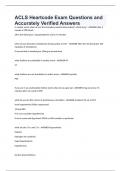
ACLS Heartcode Exam Questions and Accurately Verified Answers
in cardiac arrest when do you first introduce medical intervention? which drug? - ANSWER-after 2 rounds of CPR/shock after 2nd shock give 1 mg epinephrine every 3-5 minutes when do you introduce amiodarone during cardiac arrest? - ANSWER-after the 3rd shock give 300 mg bolus of amiodarone if second dose is needed give 150mg as second dose what rhythms are shockable in cardiac arrest - ANSWER-VF VT what rhythms are not shockable in cardiac arrest - ANSWER-asystole PEA if you are ...
- Package deal
- Exam (elaborations)
- • 19 pages •
in cardiac arrest when do you first introduce medical intervention? which drug? - ANSWER-after 2 rounds of CPR/shock after 2nd shock give 1 mg epinephrine every 3-5 minutes when do you introduce amiodarone during cardiac arrest? - ANSWER-after the 3rd shock give 300 mg bolus of amiodarone if second dose is needed give 150mg as second dose what rhythms are shockable in cardiac arrest - ANSWER-VF VT what rhythms are not shockable in cardiac arrest - ANSWER-asystole PEA if you are ...
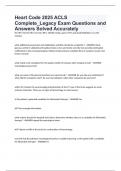
Heart Code 2025 ACLS Complete_Legacy Exam Questions and Answers Solved Accurately
the HR is 92/min RR is 14/min, BP is 130/86 mmhg, spo2 is 97% and atrial fibrillation is on the monitor what additional assessment and stabilization activities should be completed ? - ANSWER-check glucose, perform validated prehospital stroke screen and stroke severity tool, provide prehospital notification to the receiving hospital, initiate stroke protocol, establish time of symptom onset ( last known normal) what needs to be completed for this patient within 20 minutes after hospital...
- Package deal
- Exam (elaborations)
- • 4 pages •
the HR is 92/min RR is 14/min, BP is 130/86 mmhg, spo2 is 97% and atrial fibrillation is on the monitor what additional assessment and stabilization activities should be completed ? - ANSWER-check glucose, perform validated prehospital stroke screen and stroke severity tool, provide prehospital notification to the receiving hospital, initiate stroke protocol, establish time of symptom onset ( last known normal) what needs to be completed for this patient within 20 minutes after hospital...
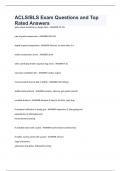
ACLS/BLS Exam Questions and Top Rated Answers
pulse check should be no longer than - ANSWER-10-15s rate of good compression - ANSWER-100-120 depth of good compression - ANSWER-2inches, no more than 2.4 switch compressors every - ANSWER-2min with a perfusing rhythm squeeze bag every - ANSWER-5-6s excessive ventilation dec - ANSWER-cardiac output recommended dose of ASA in STEMI - ANSWER-160-325mg stable brady protocol - ANSWER-monitor, observe, get expert consult unstable brady tx - ANSWER-atropine 0.5mg IV q3-5min,...
- Package deal
- Exam (elaborations)
- • 7 pages •
pulse check should be no longer than - ANSWER-10-15s rate of good compression - ANSWER-100-120 depth of good compression - ANSWER-2inches, no more than 2.4 switch compressors every - ANSWER-2min with a perfusing rhythm squeeze bag every - ANSWER-5-6s excessive ventilation dec - ANSWER-cardiac output recommended dose of ASA in STEMI - ANSWER-160-325mg stable brady protocol - ANSWER-monitor, observe, get expert consult unstable brady tx - ANSWER-atropine 0.5mg IV q3-5min,...

ACLS - Practical Exam Questions and Accurately Solved Answers
Patient complains of chest pain: first step? - ANSWER--assess for perfusion What instructions do you give your team as soon as you arrive on scene? - ANSWER-1. start IV 2. start O2 3. start monitoring What medications do you provide your patient with right away? - ANSWER-1. oxygen w/ nonrebreather at 10 L/minute 2. NTG 400 mcg x2 sprays 3. Aspirin 325 mg chewed 4. Morphine 4 mg IV What should be done in between every spray of NTG? - ANSWER--check blood pressure After recei...
- Package deal
- Exam (elaborations)
- • 4 pages •
Patient complains of chest pain: first step? - ANSWER--assess for perfusion What instructions do you give your team as soon as you arrive on scene? - ANSWER-1. start IV 2. start O2 3. start monitoring What medications do you provide your patient with right away? - ANSWER-1. oxygen w/ nonrebreather at 10 L/minute 2. NTG 400 mcg x2 sprays 3. Aspirin 325 mg chewed 4. Morphine 4 mg IV What should be done in between every spray of NTG? - ANSWER--check blood pressure After recei...

ACLS Study Notes Exam Questions and Verified Answers
Adult Cardiac Arrest Algorithm - ANSWER- What are the shockable rhythms? - ANSWER-VF and pulseless VT What are nonshockable rhythms? - ANSWER-Asystole/ PEA Reversible causes of cardiac arrest (H's) - ANSWER-Hypovolemia Hypothermia Hypo/Hyperkalemia Hydrogen Ion (Acidosis) Hypoxia Reversible causes of cardiac arrest (T's) - ANSWER-Toxins Tension Pneumothorax Tamponade, Cardiac Thrombosis, coronary Thrombosis, pulmonary How often do we give Epinephrine in a cardiac arrest...
- Package deal
- Exam (elaborations)
- • 5 pages •
Adult Cardiac Arrest Algorithm - ANSWER- What are the shockable rhythms? - ANSWER-VF and pulseless VT What are nonshockable rhythms? - ANSWER-Asystole/ PEA Reversible causes of cardiac arrest (H's) - ANSWER-Hypovolemia Hypothermia Hypo/Hyperkalemia Hydrogen Ion (Acidosis) Hypoxia Reversible causes of cardiac arrest (T's) - ANSWER-Toxins Tension Pneumothorax Tamponade, Cardiac Thrombosis, coronary Thrombosis, pulmonary How often do we give Epinephrine in a cardiac arrest...
